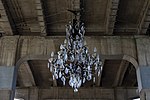Granville Street Bridge
Bridges completed in 1889Bridges completed in 1909Bridges completed in 1954Bridges in Greater VancouverBuildings and structures in Vancouver ... and 2 more
Road bridges in British ColumbiaTruss arch bridges

The Granville Street Bridge is an eight lane bridge in Vancouver, British Columbia, bridging Downtown Vancouver southwest to the Fairview neighborhood. It spans False Creek and is 27.4 metres above Granville Island. It is part of Highway 99.
Excerpt from the Wikipedia article Granville Street Bridge (License: CC BY-SA 3.0, Authors, Images).Granville Street Bridge
Anderson Street, Vancouver
Geographical coordinates (GPS) Address External links Nearby Places Show on map
Geographical coordinates (GPS)
| Latitude | Longitude |
|---|---|
| N 49.272551 ° | E -123.133049 ° |
Address
Granville Bridge
Anderson Street
V6J Vancouver (Fairview)
British Columbia, Canada
Open on Google Maps










